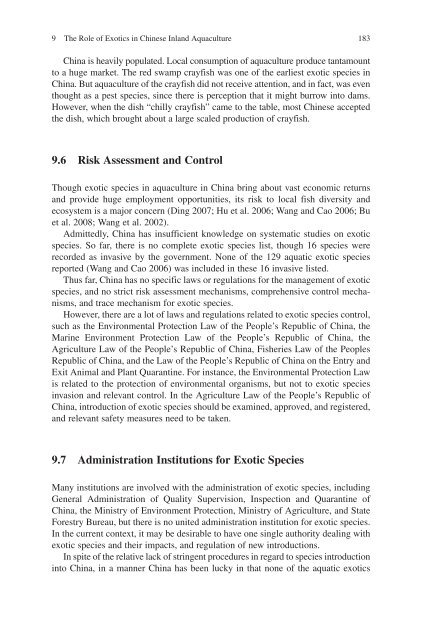9 The Role <strong>of</strong> Exotics in Chinese <strong>In</strong>land <strong>Aquaculture</strong>183China is heavily populated. Local consumption <strong>of</strong> aquaculture produce tantamountto a huge market. The red swamp crayfish was one <strong>of</strong> the earliest exotic species inChina. But aquaculture <strong>of</strong> the crayfish did not receive attention, and in fact, was eventhought as a pest species, since there is perception that it might burrow into dams.However, when the dish “chilly crayfish” came to the table, most Chinese acceptedthe dish, which brought about a large scaled production <strong>of</strong> crayfish.9.6 Risk Assessment and ControlThough exotic species in aquaculture in China bring about vast economic returnsand provide huge employment opportunities, its risk to local fish diversity andecosystem is a major concern (Ding 2007 ; Hu et al. 2006; Wang and Cao 2006 ; Buet al. 2008 ; Wang et al. 2002) .Admittedly, China has insufficient knowledge on systematic studies on exoticspecies. So far, there is no complete exotic species list, though 16 species wererecorded as invasive by the government. None <strong>of</strong> the 129 aquatic exotic speciesreported (Wang and Cao 2006) was included in these 16 invasive listed.Thus far, China has no specific laws or regulations for the management <strong>of</strong> exoticspecies, and no strict risk assessment mechanisms, comprehensive control mechanisms,and trace mechanism for exotic species.However, there are a lot <strong>of</strong> laws and regulations related to exotic species control,such as the Environmental Protection Law <strong>of</strong> the People’s Republic <strong>of</strong> China, theMarine Environment Protection Law <strong>of</strong> the People’s Republic <strong>of</strong> China, theAgriculture Law <strong>of</strong> the People’s Republic <strong>of</strong> China, Fisheries Law <strong>of</strong> the PeoplesRepublic <strong>of</strong> China, and the Law <strong>of</strong> the People’s Republic <strong>of</strong> China on the Entry andExit Animal and Plant Quarantine. For instance, the Environmental Protection Lawis related to the protection <strong>of</strong> environmental organisms, but not to exotic speciesinvasion and relevant control. <strong>In</strong> the Agriculture Law <strong>of</strong> the People’s Republic <strong>of</strong>China, introduction <strong>of</strong> exotic species should be examined, approved, and registered,and relevant safety measures need to be taken.9.7 Administration <strong>In</strong>stitutions for Exotic SpeciesMany institutions are involved with the administration <strong>of</strong> exotic species, includingGeneral Administration <strong>of</strong> Quality Supervision, <strong>In</strong>spection and Quarantine <strong>of</strong>China, the Ministry <strong>of</strong> Environment Protection, Ministry <strong>of</strong> Agriculture, and StateForestry Bureau, but there is no united administration institution for exotic species.<strong>In</strong> the current context, it may be desirable to have one single authority dealing withexotic species and their impacts, and regulation <strong>of</strong> new introductions.<strong>In</strong> spite <strong>of</strong> the relative lack <strong>of</strong> stringent procedures in regard to species introductioninto China, in a manner China has been lucky in that none <strong>of</strong> the aquatic exotics
184 J. Liu and Z. Lispecies introduced for aquaculture purpose has been invasive, and has not impactedadversely on biodiversity. Perhaps, this is mainly due to these species not been ableto establish natural reproductive populations because <strong>of</strong> the extreme climates experiencedin the regions in China into which these species have been introduced into.However, this is no reason for complacency. The fact that China has recognized allthe complexities <strong>of</strong> introductions and the need to set up the required administrativeand institutional backing is most welcome.ReferencesBu, Y., C. Xie, X. Liu, and Y. Ren. 2008. Environmental risk assessment <strong>of</strong> introduced species.Reservoir Fisheries 28: 82–84. <strong>In</strong> Chinese.Chen, P., B. Xiong, G. Lu, J. Wang, and Z. Dai. 2008. <strong>Aquaculture</strong> status and prospects <strong>of</strong> theAmerican paddlefish. Acta Agriculture Jiangxi 20: 88–89. <strong>In</strong> Chinese.CMA (Chinese Ministry <strong>of</strong> Agriculture). 2004. The criterion <strong>of</strong> channel catfish aquaculture .China Agricultural Press (in Chinese): Beijing.De Silva, S.S., R.P. Subasinghe, D.M. Bartley, and A. Lowther. 2004. Tilapias as alien aquatics inAsia and the Pacific: A review. FAO Fisheries Technical Paper 453: 65 pp.De Silva, S.S., T.T.T. Nguyen, N.W. Abery, and U.S. Amarasinghe. 2006. An evaluation <strong>of</strong> the roleand impacts <strong>of</strong> alien finfish in <strong>Asian</strong> inland aquaculture. <strong>Aquaculture</strong> Research 37: 1–17.De Silva, S.S., Nguyen, Thuy T.T., Turchini G.M., Amarasinghe U.S., Abery N.W., 2009. Alienspecies in aquaculture and biodiversity: a paradox in food production. Ambio 38: 24–28.Ding, D. 2007. Healthy culture <strong>of</strong> big sized channel catfish fingerlings in cages. <strong>In</strong>land Fisheries2: 22–23. <strong>In</strong> Chinese.FBMA (Fisheries Bureau <strong>of</strong> Ministry <strong>of</strong> Agriculture). 2007. China fishery statistical yearbook .China Agriculture Press: Beijing (in Chinese).Gozlan, R.E. 2008. <strong>In</strong>troduction <strong>of</strong> non-native freshwater finfish: Is it all bad? Fish and Fisheries9: 106–115.He, Y. 1999. Development prospects <strong>of</strong> the American paddlefish and aquaculture techniques.China Fisheries 4: 25–27. <strong>In</strong> Chinese.He, G. 2006. Control <strong>of</strong> gill erosion disease <strong>of</strong> channel catfish induced by the syndrome <strong>of</strong> liverand gall. Reservoir Fisheries 4: 92–93. <strong>In</strong> Chinese.He, G., S. Hu, C. Li, L. Zou, and G. Zhao. 2003. The criterion for cage culture <strong>of</strong> channel catfish .Hubei Provincial Bureau <strong>of</strong> Quality and Technique Surveillance (in Chinese): Wuhan.Hu, S. and J. Peng. 2008. Status and development trend <strong>of</strong> channel catfish industry in reservoirs<strong>of</strong> the Qingjiang River, Hubei. Reservoir Fisheries 28: 108–109. <strong>In</strong> Chinese.Huang, A. 2008a. Artificial propagation <strong>of</strong> the channel catfish and environment-friendly rearing<strong>of</strong> the fry and fingerlings. Scientific Fish Farming 4: 14–16. <strong>In</strong> Chinese.Huang, A. 2008b. Artificial propagation <strong>of</strong> the channel catfish and environment-friendly rearing<strong>of</strong> the fry and fingerlings. Scientific Fish Farming 5: 14–16. <strong>In</strong> Chinese.Huang, A. 2008c. Artificial propagation <strong>of</strong> the channel catfish and environment-friendly rearing<strong>of</strong> the fry and fingerlings. Scientific Fish Farming 6: 14–16. <strong>In</strong> Chinese.Li, A. 2002. Nutrition and feeds <strong>of</strong> aquatic organisms . China Agricultural Press: Beijing (inChinese).Li, X., A. Li, X. Peng, and G. Cheng. 2007. <strong>In</strong>troduction and stock resources protection <strong>of</strong> tilapiain China. Henan Fisheries 1: 3–6. <strong>In</strong> Chinese.Liu, J. and Z. Yu. 1990. The American paddlefish and its fisheries in the U. S. A. ActaHydrobiologia 14(1): 75–83. <strong>In</strong> Chinese.Luo, H., H. Lu, and H. Wang. 2008. Healthy production <strong>of</strong> channel catfish in reservoir cages.<strong>In</strong>land Fisheries 4: 45–46. <strong>In</strong> Chinese.
















